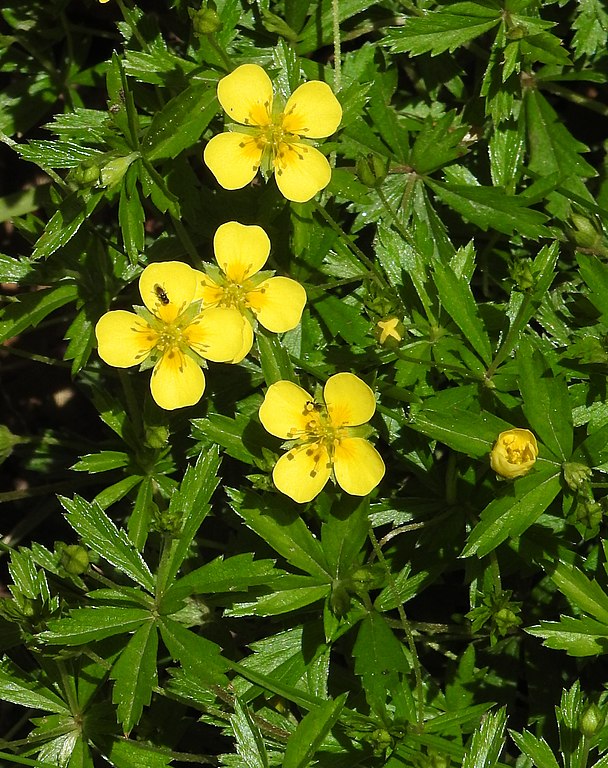
 |  |  |   |   |
 |  |  |
Tormentil
- a perennial plant with a height of 10-40 cm. In the plant, the rhizome is cylindrical, tuberous, enlarged, woody, reddish-brownish, many rhizomes grow on it.
Leaves at the rhizome three-parted or five-parted on long petioles. Stem leaves three-parted, sessile. Single flowers on a long peduncle, up to 1 cm in diameter, were rare in the plant. The flower consists of yellow petals.
The
Tormentil
begins to bloom from mid-May until September. The fruit ripens in August, September.
The
Tormentil
rhizome (Potentillae rhizomata) is used for medicinal purposes. The rhizomes are dug during flowering, cleaned from the roots, washed from the ground and dried in the fresh air, in well-ventilated rooms or forced dryers not exceeding 60C. In order to preserve the maximum amount of valuable substances, it is better to use forced dryers. Before drying, we cut the root into smaller pieces, because it will be impossible to cut them after drying.
The pharmacological activity is determined by the plant's biologically active substances, which the plant contains. The root contains up to 30% tannin, glycoside tormentilin, triterpenoids up to 6% (hynovic acid and tormentoside), resin, crystalline ether tormentol, malic acid, ascorbic acid, phenol carbonate acids: gallic acid, quinone acid, ellagic acid, caffeic acid, n-coumaric acid, protocatechinic acid, flavonoids ( kaempferol), flobafens, phenols (phloroglucin, pyrocatechin, pyrogallol), catechin, wax, rubbers, starch, macro and micro elements (copper, iron, manganese, magnesium, selenium, etc.)
Medicinal significance
The rhizomes of the plant have astringent, anti-inflammatory, blood-restoring, bactericidal effects, and also have expectorant and choleretic effects.
It has been established that water infusions of the
Tormentil
rhizome have antimicrobial, antiprotozoal and fungicidal effects. The antimicrobial effect of the decoction on the intestinal microflora is peculiar. Its effect is mild and physiological, as its active substances are essentially eubiotic and pathogenic agents do not develop resistance to them. Therefore, decoctions are rarely used to treat diseases associated with functional disorders of the intestines. In addition to treatment, a decoction of the
Tormentil
rhizome protects the intestinal walls from irritation and damage by microbes or other adverse agents, removes acute inflammatory reactions, stabilizes intestinal motility, suppresses pathogenic intestinal flora and restores eubiosis in the intestines.
The general anti-inflammatory action is related to the flavonoids present in the plant, but local to tannins that are able to create a biological protective film that protects the tissue from bacteria, chemical and mechanical effects accompanied by inflammation, while reducing capillary permeability and narrowing blood vessels.
Diarrhea can be successfully treated with preparations of the
Tormentil
root of the plant, as well as helicobacter pylori, which often resides in the stomach, can be used in monotherapies or mixed with other remedies, without interfering with the effect of these remedies. One of the best features of this plant is that it is very rarely intolerable and is suitable for all age groups. However, due to the high concentration of tannins, you should always remember the drying effect of this plant on the mucous membrane.
In folk medicine, decoction, infusion, tea and even infusion of this plant on alcohol are used. Basically, the
Tormentil
is used as an astringent, expectorant and pain reliever. The rhizome of the plant is an ancient folk medicine for the treatment of gastritis, stomach ulcers, as well as various internal bleedings (lungs, stomach, intestines, uterus). In case of diarrhea or dysentery, tea from the rhizome was drunk. A decoction of the rhizome was used to treat digestive tract and insufficient acidity of stomach acid.
It was also used externally, as an ingredient in an ointment to heal burns, frostbite, dampness, and as a mouth rinse for angina and scurvy. The
Tormentil
root was also used in case of jaundice, liver diseases, gout; in the composition of mixtures - for various diseases of the kidneys, bladder and prostate adenoma.
There are positive observations about the decoction of the rhizome, stem, leaves and flowers of the plant to treat acute and chronic hepatitis patients, as well as those with cirrhosis of the liver with symptoms of accumulation (edema, ascites).
For men
In mixtures with other herbs, it is used to treat prostate adenoma.